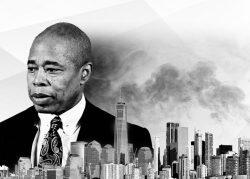Mary Anne Rothman is concerned about Local Law 97 because it seems like nobody else is.
The ambitious law, passed in 2019, sets greenhouse gas emission caps for buildings across New York City. The biggest carbon producers — around 5,400 buildings — have until 2024 to get under their emissions caps. The rest of the top 75 percent of emitters have until 2030.
Buildings are responsible for 70 percent of New York’s globe-warming emissions, and multifamily buildings are the biggest culprits. Boilers, furnaces and water heaters alone make up 40 percent of New York’s carbon emissions.
But as the first compliance deadline nears, some co-ops and condominiums are struggling to line up financing and construction services to get legal before the law’s stiff penalties kick in.
Each building’s emissions limit is based on its size and type. Supermarkets, for example, can emit more than condos, because they need massive refrigerators to keep food from spoiling.
But one frightening constant applies to all buildings, regardless of how densely occupied they are: For each ton of emissions over the limit, the fine is up to $268.
“Everyone is not thrilled by this legislation,” said Rothman, executive director for the Council of New York Cooperatives & Condominiums, in something of an understatement.
The real estate industry has for years been seeking changes to the law, but the objections have come almost entirely from commercial property owners. Condos and co-ops have been virtually absent from the conversation.
Many members of that world don’t even know about the law. Rothman could not recall a single conversation about it with condo or co-op board members in the past eight months.
“What scares me most,” Rothman said, “is how few New Yorkers are tuned into this at this late date.”
People in glass houses
New York’s taste for glass skyscrapers has made compliance complicated. In 2010 the city introduced its first energy code, which aimed to make construction more efficient. Apartments built since then use half as much fuel per square foot as those constructed before 1980, according to the Urban Green Council.
The city later passed more efficiency measures that have pushed builders toward green technology, such as better insulation and tighter building wrappers.
But, as Dutch architect Stefan Al writes in his book “Supertall” about modern skyscrapers, contemporary tastes have made it harder to design environmentally.
The taller a skyscraper gets, the more pressure its upper floors exert on lower ones. That’s why ancient architects built their tall structures with wide bases and smaller apexes. The tapering approach worked for the pyramids, but in a dense metropolis with expensive land like Manhattan, a developer has no room for a wide base to support an 80-floor highrise.
Instead, builders have to rely on one of the marvels of modern construction: concrete.
Today’s concrete is exceptionally strong: A table-sized slab of it in the half-mile-high Burj Khalifa could support the Eiffel Tower. But environmentally speaking, concrete is the emissions equivalent of a two-pack-a-day smoker.
Producing cement, the glue that binds concrete together, demands significant amounts of fossil fuel. All told, concrete is responsible for 5 to 8 percent of the world’s fossil fuel expenditures.
The good news for city buildings is that past emissions from construction do not count toward Local Law 97 limits. The bad news is that retrofitting old properties built before energy efficiency was a thing is ghastly expensive.
Newer ones have their own emissions issues. Glass towers that climb hundreds of feet into the air and bake in unobstructed sunlight require powerful air conditioning systems. Air conditioning accounts for 10 percent of U.S. emissions.
Read more



One57, the Extell Development Billionaires’ Row condo tower that launched the Manhattan supertall boom, emits more than 5,600 tons of carbon a year, according to the latest city benchmarking figures (current through 2020). But Local Law 97 allows One57 no more than 5,000 tons. That means the building could be fined $200,000 a year.
Zeckendorf Development’s 15 Central Park West, one of the city’s most lucrative condos ever, appears to be nearly 125 tons past its limit. That comes out to a $33,000 fine.
But those are rounding errors for new, ultra-luxury buildings, where monthly common charges for a single apartment can be five figures.
Age before beauty
Older condominiums not sealed as tight as new construction face a steep climb to get in shape for Local Law 97. Marc Schwartz, a member of the 1235 Park Avenue condo board, views his 60-unit, 1928 building like an aging parent.
“My dad’s around the same age, and they’re both constantly in need of a bypass or something,” Schwartz said. Orsid, the building’s property manager, approached Schwartz in 2019 to tell him the building needed to get its act together.
The building brought on a contractor to identify how it could reach compliance. Since then, the board has added small efficiencies as maintenance needs arise: better insulation to accompany a new roof and modern steam heating valves, for example.
“A lot of the work we did 10, 15 years ago is now coming back to help us,” Schwartz said. “But if you had to do all this at once, it’s a big problem.”
Orsid launched an information blitz to get the nearly 200 co-ops and condos it manages up to speed with the law’s deadlines. “People think, ‘Oh, compliance, I just need to check a box,’” said Dennis de Paola, an executive at the company. “That’s not how this works.”
It can be particularly difficult for condos, where residents own their units rather than shares in the building, and may be resistant to change. There can also be delays in financing and difficulty lining up contractors.
At a recent question-and-answer session, city employees ran 17 attendees through various ways to finance retrofits. While there are plenty of options — through Con Ed, NYSERDA, HPD and others — owners seem inundated with information, if they are paying attention at all.
It can even be complicated for public officials whose jobs revolve around housing. Pierina Sanchez, who chairs the City Council’s Housing and Buildings Committee, lives in a 75-unit co-op, one of the buildings that must reduce its emissions by the 2024 deadline. Sanchez says they lack the engineers to help get into compliance.
“I personally feel the pain, along with my neighbors,” Sanchez said. She said raising even a couple hundred dollars per unit could be “catastrophic” to a senior on a fixed income.
